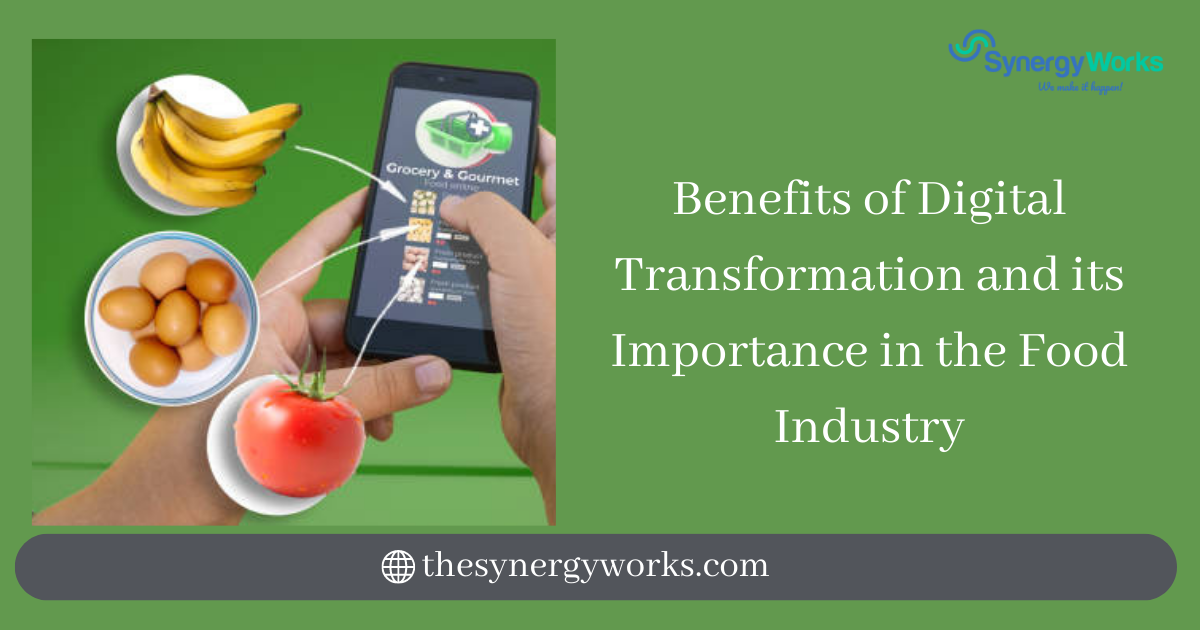Today’s world is driven by technology. Every business is trying to keep up with the constantly evolving technology to survive in the cut-throat competition and the food industry is no exception. Advanced online infrastructure with easily accessible internet connectivity has empowered customers of all industries including the food & beverage industry. The online food delivery segment has become one of the most promising business verticals in no time. In this blog, we will discuss how digital transformation has helped to convert this industry into a billion-dollar market.
Understanding Digital Transformation
Digital transformation is the process of transforming conventional businesses using digital solutions that drive growth and help in meeting the advanced needs of modern customers. It involves reviewing the existing infrastructure and modifying the internal systems as per the changing market trends. Technology plays the most crucial part in the digital transformation of any business.
Also Read: How COVID-19 Manifested The Need For Online Business Models?
Digital Transformation In The Food Sector
The most successful food players in the contemporary market are the ones that have harnessed the power of technologies in the right manner. While some businesses have already begun their journey of exponential business growth with the help of technology solutions, some are yet to realize the potential of the technology-driven food businesses. Using an effective digital transformation strategy, food businesses can define a roadmap that allows them to satisfy the constantly changing needs of demanding customers.
Unlike other online businesses, the food delivery application works a bit differently because of customer preferences and behavior. Food isn’t just another commodity that you need. It evokes physical sensations and emotions and it brings together families and friends. With the world changing rapidly, our food choices have also evolved over time, thus affecting our attitude towards it. By combining the new and affordable technologies like the Internet of Things, cloud infrastructure, data analytics, mobility, etc. we can transform food businesses into intelligent food brands that operate efficiently while offering instant gratification to their customers.
Exploring the Benefits of Digital Transformation in the Food Industry
The main benefits of digital transformation in any industry or business model are increased productivity, improved operational efficiency, predictive analysis, improved decision-making, reduced errors and risks, increased consistency, better throughput, and improved compliance.
There is no doubt that the dynamics of the food and beverage sector have changed over the years. It has become more customer-oriented and transparent, and the use of technology has increased. Let us find out the benefits of digital transformation in this industry.
Improved Recipe Agility
Digital recipe management allows manufacturers to respond flexibly to changing consumer needs. By safely modifying the number of product variants, shortening the time to market for new and packaging variants, and accelerating the new product launch process, manufacturers can remain competitive in the food and beverage market.
Enhanced Quality
Poor quality, contaminated, mislabeled, or counterfeit products reaching consumers can seriously impact your business and reduce their trust in your brand. Digitizing end-to-end traceability and quality documentation can prevent poor quality and suspicious products from reaching consumers, comply with quality and safety compliance standards, and ultimately build trust and increase consumer satisfaction while preserving brand reputation.
More Accurate Supply And Demand Forecasts
Inventory is an integral aspect of food operations that requires a significant investment for purchase and storage. When companies know demand ahead of time, they streamline cash flow and reduce risk. Software with advanced analytics can help you better understand your customers’ needs and predict seasonal demand levels to stock up in time.
Enhanced Customer Experience
It is necessary for businesses to realize that the modern customer isn’t short of choices. The market is flooded by countless brands and businesses offering the same set of products and services. However, the customers value the experience and hence choose the service providers who focus on offering memorable experiences.
Tech innovations in the food industry enable business owners to better understand their customers and offer a little more than expected. Modern quality control and traceability software, for example, prevent poor quality products from landing in the hands of consumers. It boosts business revenue while enhancing the customer experience.
Better Work Environment
The digital transformation of the food industry relates not only to the customers but also to the production workers. Workers can perform their tasks more effectively in a safe and better work environment provided by digital platforms. Along with the training simulator, augmented reality solutions help in calculating the machine’s operating parameters and provide the workers with the real-time data they need right away.
Personalized Services
With digital solutions, it is easier for companies to understand the interests and preferences of their target audience based upon the collected user data. Food businesses can make informed decisions using actionable insights, thus enabling companies to offer personalized services.
Here You Can Read More About Startup App Development
Conclusion
Food and beverage manufacturers must take advantage of the digital transformation opportunity now, and the sooner they recognize it, the better. This includes the use of a combination of tools, techniques, and approaches.
Get in touch with our experts to learn how you can implement technology in your existing food venture or set up a new business from scratch.
About Author
Shikha Taman
Shikha Taman is the founder & CEO of SynergyWorks Solutions. With over 12 years of experience in the industry. She has extensive knowledge of software engineering, project management, client management, and business strategy. She strives to ensure all the products developed are always up-to-date with materializing technologies to remain competitive in today’s marketplace.




